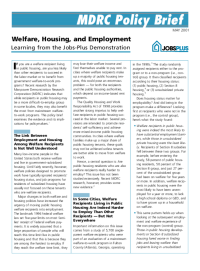Welfare, Housing, and Employment
Learning from the Jobs-Plus Demonstration
If you are a welfare recipient living in public housing, are you less likely than other recipients to succeed in the labor market or to benefit from government welfare-to-work programs?
Recent research by the Manpower Demonstration Research Corporation (MDRC) indicates that while recipients in public housing may be a more difficult-to-employ group in some locales, they may also benefit the most from mainstream welfare-to-work programs. It examines the evidence and its implications for policymakers. This policy brief was written by Susan Blank and James Riccio. It is based on an unpublished MDRC paper, written by James Riccio and Alan Orenstein, “Are Welfare Recipients in Public Housing Really Harder to Employ?” (2000). The study was supported by a grant from the Fannie Mae Foundation and the resources provided by the funders of the Jobs-Plus demonstration. This brief is one of a series on findings from the Jobs-Plus demonstration and related research.
These findings open questions that need further exploration, but they strongly suggest that public officials ought to make housing status a key consideration in developing strategies to strengthen mainstream welfare-towork programs. They also indicate that special efforts may be required in order to promote big improvements in the self-sufficiency of welfare recipients in public housing.






